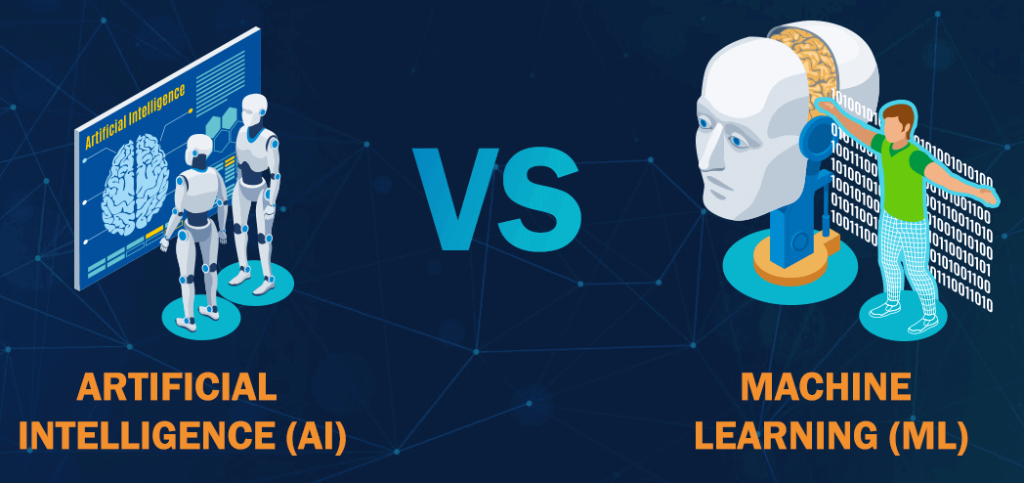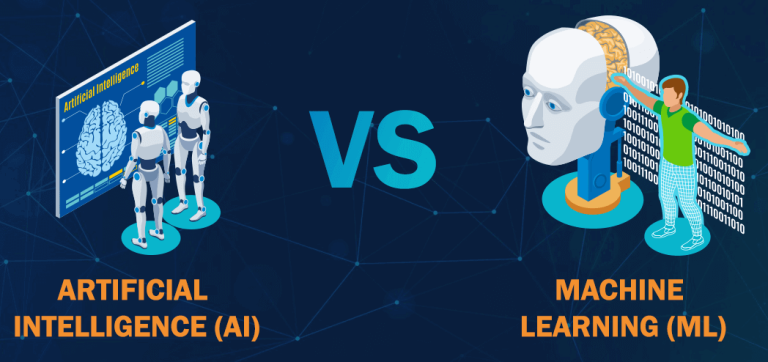When it comes to modern technology, few terms are as popular as Artificial Intelligence (AI) and Machine Learning (ML). They are often used interchangeably, but in reality, they are not the same. Understanding the difference between AI and ML is essential for students, tech professionals, and businesses looking to adopt new technologies.
In this blog, we’ll break down AI vs ML in simple terms, highlight their key differences, and explore real-world applications.

Table of Contents
What is Artificial Intelligence (AI)?
Artificial Intelligence is the broader concept of creating smart machines that can mimic human behavior. The goal of AI is to enable computers to think, learn, and make decisions like humans.
Examples of AI include:
- Virtual assistants like Siri, Alexa, and Google Assistant
- Self-driving cars
- Chatbots that answer customer queries
- AI in medical diagnosis
In short: AI is about creating machines that can simulate human intelligence.
Key Components of AI
- Learning
- The ability of machines to learn from data.
- Includes supervised learning, unsupervised learning, and reinforcement learning.
- Reasoning
- The capability to think logically and make the right decisions.
- Problem Solving
- Finding solutions to complex problems where multiple possibilities exist.
- Perception
- Understanding the environment through input like speech recognition, image recognition, and sensor data.
- Natural Language Processing (NLP)
- The ability to understand and generate human language (text and speech).
- Knowledge Representation
- Storing and organizing information in a way that machines can use it logically (facts, rules, relationships).
- Planning
- Deciding future steps to achieve specific goals.
- Robotics
- Applying AI in the physical world through robots that can perform tasks.
What is Machine Learning (ML)?
Machine Learning is a subset of AI. It focuses on enabling systems to learn from data and improve over time without being explicitly programmed. Instead of coding every rule, we provide data, and ML algorithms find patterns to make predictions or decisions.
Examples of ML include:
- Netflix or YouTube recommendation systems
- Email spam filters
- Predictive text and autocorrect
- Fraud detection in banking
In short: ML is about teaching machines to learn from experience (data).
Key Differences: Artificial Intelligence vs Machine Learning
| Feature | Artificial Intelligence (AI) | Machine Learning (ML) |
|---|---|---|
| Definition | The science of making machines think and act like humans | A subset of AI that uses data and algorithms to learn and improve |
| Goal | To simulate human intelligence | To enable machines to learn from data |
| Scope | Broad – includes ML, robotics, natural language processing | Narrow – focuses only on data-driven learning |
| Example | A chatbot that understands and replies naturally | Netflix suggesting movies based on your history |
How AI and ML Work Together
AI and ML are not competitors—they complement each other. Think of AI as the umbrella concept and ML as one of the tools that make AI possible. For example:
- AI enables a self-driving car to follow traffic rules.
- ML helps it learn driving patterns by analyzing data from millions of miles driven.
Real-World Applications
Artificial Intelligence in Action
- Healthcare: AI diagnoses diseases from X-rays and MRIs.
- Education: AI tutors provide personalized learning experiences.
- Business: AI chatbots handle customer support 24/7.
Machine Learning in Action
- E-commerce: Amazon recommends products based on browsing history.
- Finance: Banks detect unusual transactions using ML models.
- Social Media: Instagram suggests reels you might like.
Which One is More Important?
Both AI and ML are essential in today’s digital world. AI provides the framework for intelligence, while ML provides the ability to learn from data. If AI is the brain, ML is the part that helps it grow smarter with experience.
Conclusion
So, what’s the difference between Artificial Intelligence and Machine Learning?
- AI is the big picture – making machines intelligent.
- ML is a part of AI – teaching machines how to learn from data.
In 2025 and beyond, both AI and ML will continue to transform industries, from healthcare and education to entertainment and finance. Also check Top 10 Emerging Technologies of 2025.
